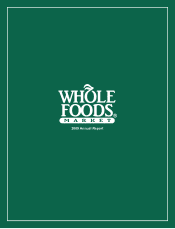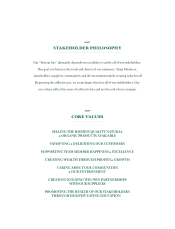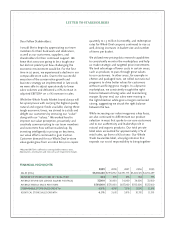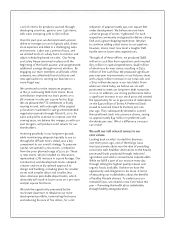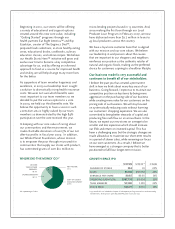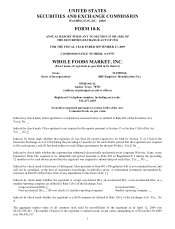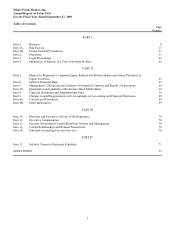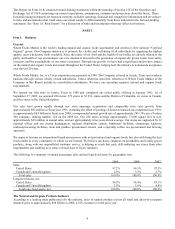Whole Foods 2009 Annual Report Download - page 4
Download and view the complete annual report
Please find page 4 of the 2009 Whole Foods annual report below. You can navigate through the pages in the report by either clicking on the pages listed below, or by using the keyword search tool below to find specific information within the annual report.
a set of criteria for products sourced through
developing countries, grew to over 1,350 items,
with sales increasing 72% to $76 million.
Over the past year, we demonstrated a proven
ability to manage our cost of goods sold, direct
store expenses and G&A in a challenging sales
environment. Labor was a primary focus, and
we utilized tools on a daily basis to monitor and
adjust scheduling based on sales. Our hiring
and salary freeze remained in place until the
beginning of the fourth quarter, and we generated
additional savings through normal attrition. By
engaging our team members at all levels of the
company, we collectively found solutions and
new approaches to running our business in a
more frugal way.
We continued to make important progress
at the 52 continuing Wild Oats stores. Store
contribution improved 150 basis points on a
5% increase in sales per square foot to $542.
We are pleased the FTC settlement is finally
nearing an end, with only eight of the original
32 locations marketed for sale granted extended
negotiation periods through March 8, 2010. As
sales and profits continue to improve over the
coming years, we believe this merger, as with our
past mergers, will produce solid returns for our
shareholders.
Investing prudently in our long-term growth,
while maintaining adequate liquidity to see us
through the difficult times ahead, was a key
component to our overall strategy. To preserve
capital, we opened 15 new stores, a reduction
from the prior planned range of 25 to 30. These
15 new stores, which included six relocations,
represented a 7% increase in square footage. Our
construction and development teams adopted
a leaner and more disciplined approach to
design and building, including plans for smaller
stores with simpler décor and smaller, less
labor-intensive perishable departments, which
ultimately will result in lower costs on a per store
and per square foot basis.
We took the opportunity presented by the
real estate downturn to rebalance our store
development portfolio, terminating five leases
and reducing the size of five others, for a net
reduction of approximately 340,000 square feet
under development. We believe we now have
a diverse group of stores “rightsized” for each
respective community and geared to deliver strong
EVA and a great shopping experience. We plan
to continue adding select stores to our pipeline;
however, stores must now meet a tougher EVA
hurdle rate on lower sales expectations.
Through all of these efforts, we produced $588
million in cash flow from operations and invested
$315 million in capital expenditures, $248 million
of which was for new stores, resulting in $273
million of free cash flow. We produced significant
year-over-year improvements in our balance sheet,
with a $470 million increase in our total cash and
a $190 million decrease in our total debt. From
where we stand today, we believe we are well
positioned to meet our long-term debt maturities
in 2012. In addition, our strong performance led to
a significant increase in our stock price and created
the opportunity for us to give notice of redemption
on the $425 million of Series A Preferred Stock
issued to Leonard Green & Partners just one
year ago. They subsequently elected to convert
their preferred stock into common shares, saving
us approximately $34 million in preferred cash
dividends per year. What a difference one year
can make!
We walk our talk when it comes to our
core values.
Looking back on why I started this business
over thirty years ago, one of the things I was
most passionate about was the idea of providing
customers with healthier alternatives to the heavily
processed foods produced through industrial
agriculture and sold in conventional supermarkets.
While we fulfill a part of our mission every day
through selling the highest quality natural and
organic foods available, I believe we have the
opportunity and obligation to do more in terms
of educating our stakeholders about the benefits
of healthy lifestyle choices. To underscore our
renewed focus, we created a new Core Value this
year – Promot ing the health of our stakeholders
through healthy eating education.

